

Joe Bergeron's Astronomy
Equipment Reviews
Televue Pronto
Questar 3.5"
Starsplitter 10" Compact
Coronado PST
Denkmeier II Binoviewer
Losmandy G-11 Mount
Desert Sky Astro DSV-1 Mount
Telrad
Rigel Quikfinder
Televue Quickpoint
Televue Starbeam
Astro-Physics Maxbright Diagonal
Televue Radian Eyepieces
Televue Nagler Type 6 Eyepieces
Stellarvue F50 Finder
VERNONscope Brandon 94mm Refractor
78mm f/6.5 Jaegers Refractor
14.5" Sky Designs Dobsonian
I used my first Pronto on a TeleVue Gibraltar mount, which was certainly up to the task, but was not overkill in my opinion. The second one sat on a Manfrotto tripod and a TeleVue Telepod head. The Pronto balance plate accessory was a necessity in both cases. The scopes didn't balance worth a darn without it.
The best way of describing my results is to quote from a letter I wrote to Al Nagler about the older scope:
"I recently had my first chance at extended use of the Pronto beneath truly clear, dark, summer skies, with the Milky Way arching high overhead. With a 35mm Panoptic and UHC filter in place, I went hunting for the huge nebulae that don't fit in the field of my larger scopes. I was very pleased by the results. The entire field of Gamma Cygni was a bright intermix of complex light and dark nebulae. These very faint IC objects formed a stark mottling of darkness and light.
I then moved a bit to the north for the finest view of the North America nebula I've ever had. At 14x, it and the Pelican were perfectly framed. The North America was very stark and bright and looked like a ghostly map of the continent, albeit mirror reversed. The Pelican was much fainter, but still obviously there, and quite detailed. Even more impressively, the whole surrounding area was filled with large star clouds and masses of nebulosity, stuff not even plotted in Uranometria. These are things you normally see in deep wide-field photographs of this region, but you don't expect to see them visually. Peering around at all this faint, glowing stuff gave me a curious feeling of intimacy with the Galaxy, of seeing things that are supposed to be hidden or invisible.
I was able to spot the planetary nebula IC 1295 in Scutum, next to the bright globular NGC 6712. M33 was an easy, forthright oval using the 22mm Panoptic, scarcely living up to its reputation of being a challenging object. I also found that I could partially resolve the brightest globulars like M13 and M22 at high powers.
When you combine the Pronto's ability to provide crisp planetary views with its excellent wide-field performance, it becomes a very versatile little package which would be hard to match with any other portable instrument. For an astronomer who needs both extreme portability and pleasing views of all major classes of objects, Pronto is an great choice. The mechanical qualities are also outstanding. Every time I tweak or focus mine I'm reminded that I'm dealing with a high-quality piece of hardware. I'm happy to own one."
Besides that memorable session, I had a lot of fun looking at comets Hyakutake and Hale-Bopp with the Pronto. They were magnificent for scanning the southern Milky Way from dark sites. When I compared the Pronto to the Questar, I found that although the image was somewhat dimmer in the Pronto, planetary detail was about the same, presumably because of the Pronto's greater contrast. Overall, it was a more versatile scope than the Q for visual use because of its potential for very wide fields. It was also one of the prettiest scopes I've ever owned. In its simple, clean, functional way, I found it the aesthetic equal of the Questar. The Pronto was also the perfect companion for the 40mm or 60mm Coronado SolarMax H-Alpha filters, as I discovered while I was caretaker of my former astronomy club's 40mm SolarMax.

 I'm pleased (and
surprised) to find myself owning a 3.5" Questar. It's a miniature
optical and mechanical marvel, the equivalent of a driven, fully
mounted long-focus 3" refractor in a case just a bit bigger than a
lunch box. I've admired these little jewels since I was a kid,
though I overestimated their potential, encouraged to do so by
Questar's extremely optimistic advertising. For example, my first
serious telescope was an 80mm f/15 Jaegers refractor. I always
assumed a Questar would be a step up, since not only did it have a
bit more aperture, it was a Questar, not some $150
home-assembled scope. Now I'm not so sure.
I'm pleased (and
surprised) to find myself owning a 3.5" Questar. It's a miniature
optical and mechanical marvel, the equivalent of a driven, fully
mounted long-focus 3" refractor in a case just a bit bigger than a
lunch box. I've admired these little jewels since I was a kid,
though I overestimated their potential, encouraged to do so by
Questar's extremely optimistic advertising. For example, my first
serious telescope was an 80mm f/15 Jaegers refractor. I always
assumed a Questar would be a step up, since not only did it have a
bit more aperture, it was a Questar, not some $150
home-assembled scope. Now I'm not so sure.
In 1976 my mother
shocked me by actually buying one of the expensive little
things, mostly for use as a birding scope. But she never used it
all that much, leading her to give it to in 1993. I've never
gotten a cooler gift. This is certainly the only way I, a
perennially starving artist, would ever have owned one!
I once did a limiting
magnitude test on the Q, coming up with a respectable figure of
12.6. Although I wouldn't use it to probe the dimmer reaches of
the NGC, it gives surprisingly good views of brighter deep sky
objects, resolving M13 and a few other globulars fairly well at
high powers. The hoods of Comet Hale-Bopp showed up well.
Besides its limited light grasp, its main drawback as a deep sky
scope is its inability to give a wide field of view. You can't
get much more than a degree out of it, due primarily to the
narrow main baffle and the tiny opening in the mirror, which
produces vignetting in any long focus eyepiece. It's a nice
scope for quick looks at the moon, sun, and planets, though this
can be hindered by the long cool-down time (mine has a Pyrex
mirror). As a quick moon-viewer on a bright evening it's a good
companion. Lunar images hold up well at over 200X. Planetary
detail is abundant enough to give some idea of what's going on,
though I doubt many serious planetary observers rely on them. My
92mm Astro-Physics Stowaway refractor completely outclasses it
on the planets.
I splurged and added
the Questar Powerguide, which replaces the old synchronous motor
and AC electrical cord with a DC servo motor powered by an
internal 9-volt battery. This greatly enhances the handiness and
portability of the telescope.
Nice as it is, I
wouldn't recommend a Questar to anyone to whom money means much
of anything. If you can afford the price without wincing, it's
the best extremely portable complete telescope available. But at
over $4000 for a new one, its capabilities are limited for the
price. The one attribute which might make it worth part of that
premium is its portability. It might be the best eclipse travel
scope in the world, a complete system in one small case (if you
can count on finding a place to use the tabletop tripod legs).
The TeleVue 76
refractor, or even a used Pronto, is a good substitute if the Q
is too expensive. Used Questars are not hard to find, and good
ones can be found for around $2,000. Even a somewhat battered
one can be restored to new condition by Questar, though this
isn't cheap, and may not be worth it if the optics are damaged.
I love my 155mm
Astro-Physics EDT! But it's not the most portable thing in the
world. It takes about twenty minutes to set it up or take it
down.
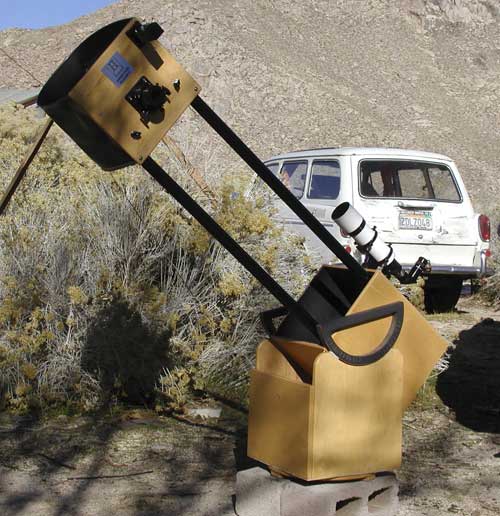 About fourteen years
ago I saw the then-new Starsplitter Compact two-pole truss Dob
design and thought it might be just what I was looking for: a
highly compact, quick to set up scope, ideal for car travel and
camping, yet big enough that I need not feel deprived by the
absence of the big refractor. I ordered a 10" f/6. It has turned
out to be a good choice, though it's not the simple delight my
other scopes are. Once everything is working right, the views
are really excellent. The Nova mirror was originally a bit
astigmatic and had to be sent back. Steve Dodds at Nova did a
great job of fixing it. Now it's probably the best mirror I've
ever owned. With a small 1.8" diagonal mirror, the deep-sky
views easily surpass those of the 155 EDT, while planetary views
are comparable, or even superior when conditions are very good.
About fourteen years
ago I saw the then-new Starsplitter Compact two-pole truss Dob
design and thought it might be just what I was looking for: a
highly compact, quick to set up scope, ideal for car travel and
camping, yet big enough that I need not feel deprived by the
absence of the big refractor. I ordered a 10" f/6. It has turned
out to be a good choice, though it's not the simple delight my
other scopes are. Once everything is working right, the views
are really excellent. The Nova mirror was originally a bit
astigmatic and had to be sent back. Steve Dodds at Nova did a
great job of fixing it. Now it's probably the best mirror I've
ever owned. With a small 1.8" diagonal mirror, the deep-sky
views easily surpass those of the 155 EDT, while planetary views
are comparable, or even superior when conditions are very good.
Alas, getting
everything to that sublime state of perfection isn't as easy as
I'd like. For one thing, the full-thickness Pyrex mirror takes a
long time to cool down, exacerbated by the unventilated design
of the mirror box.
The curved diagonal holder is prone to vibration, though if you move the scope gently it isn't an issue. The shroud is well-made, but not well-fitted. It's a bit baggy, quick to sag into the optical path if it gets wet, or blown into it by a breeze. I've modified the shroud to create a tauter fit. The eyepiece unavoidably sticks straight out from the side of the scope, which is uncomfortable when viewing objects at low altitudes. Dew on the secondary mirror can be an issue, but I resolved that by installing a heater. Finally, the scope is too short for me at my awesome height of 6'2". I have to bend down to look through it even when it's at the zenith, and when pointed low I have to practically sit on the ground. I usually stand it on a couple of cinder blocks, which helps a lot.
This is not to say that
the telescope is lacking in good qualities! The JMI 2" Crayford
focuser is nice. The Astro Systems diagonal holder works well.
Overall construction quality is high. The original mirror cell
was very poor, but then Starsplitter upgraded them to a metal
design, and Jim Brunkella was kind enough to give me one. The
scope moves very smoothly. Its portability cannot be faulted.
It's impressive to be able to pick up and carry an entire 10"
telescope. It only weighs about 50 pounds and sets up in just a
few minutes.
All in all, I'd call
the scope a worthwhile compromise. It's easy to get it where I'm
going. Once it's cooled down and collimated, it gives some of
the finest views I've ever had.
 The PST is truly the
most sublime $500 an astronomer can spend (well, as long as he
already has a good nighttime telescope). Right out of the box it
shows bright, detailed views of solar prominences as well as
surprisingly fine views of filaments, plages, and other surface
features. With the added 40mm etalon it delivers views of even
higher contrast, with very dark filaments, luminous active
regions, and swirly "spiculation" that looks like iron filings
arranged by a magnet. It could hardly be more compact, and its
design is elegant and easy to use, especially its ingenious
built-in solar finder. What a totally cool thing. Note that even
Sun Boy of the Legion of Super-Heroes approves of this instrument.
The PST is truly the
most sublime $500 an astronomer can spend (well, as long as he
already has a good nighttime telescope). Right out of the box it
shows bright, detailed views of solar prominences as well as
surprisingly fine views of filaments, plages, and other surface
features. With the added 40mm etalon it delivers views of even
higher contrast, with very dark filaments, luminous active
regions, and swirly "spiculation" that looks like iron filings
arranged by a magnet. It could hardly be more compact, and its
design is elegant and easy to use, especially its ingenious
built-in solar finder. What a totally cool thing. Note that even
Sun Boy of the Legion of Super-Heroes approves of this instrument.
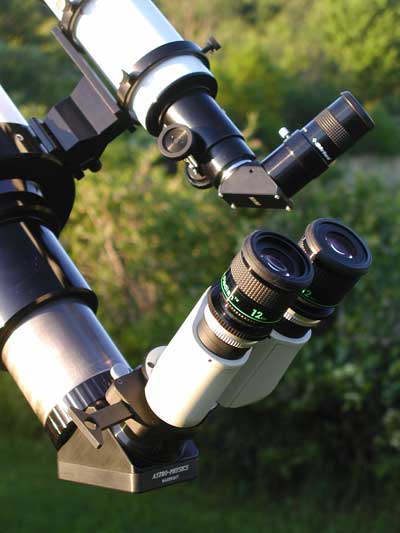 Having admired the views available though binoviewered
scopes for several years, in the spring of 2005 I finally
spent the big bucks needed to get into this type of observing.
After considering the Baader viewer sold by Astro-Physics, I
settled on the Denkmeier II with its three-position Power X
Switch because of the flexibility, convenience, and lesser
cost of the system.
Having admired the views available though binoviewered
scopes for several years, in the spring of 2005 I finally
spent the big bucks needed to get into this type of observing.
After considering the Baader viewer sold by Astro-Physics, I
settled on the Denkmeier II with its three-position Power X
Switch because of the flexibility, convenience, and lesser
cost of the system.
My chief selection criterion was
to preserve the planetary performance of my various
telescopes, which immediately led me to the more expensive
Denk II rather than the Standard with its less precise prisms.
I have seen nothing to indicate I made a mistake. With my 6"
refractor, binoed lunar views are hypnotically sublime.
Cruising in comfort over the lunar surface at 250X or so, I
notice subtle features that escaped me before. Domes, fine
rilles, crater chains, wrinkle ridges, and even color
variations call for attention from my fascinated eyes. Slewing
reveals one strange alien landscape after another, all
appearing more real and psychologically convincing than ever
before. Lunar maria are covered with wispy streaks and
patterns.
Jupiter hangs in space as an
intricately-inscribed little ball surrounded by the tiny
pearls of moons. Mars can be studied in comfort while waiting
for the brief moments that reveal the most detail on its small
disk.
Double stars are exquisite with
the binoviewer, their perfect images razor sharp, looking
almost startlingly real as they float in the field of view.
With the 6", binoed deep sky
views are impressive, but are fainter than a single-eyed view,
leading me to prefer the one-eyed view with this smallish
scope. Star clusters suffer in particular, as the individual
stars are clearly dimmer in the binoviewer. With a scope
having more light to spare I would probably feel otherwise.
Using the binoviewer under truly dark skies makes the dimming
considerably less obvious.
Using the scope with the heavy
viewer in place is somewhat awkward. It will rotate the
diagonal in the focuser if the viewer isn't sticking straight
up, unless the compression ring holding the 2" diagonal is
firmly locked down. These issues arise mainly when switching
from target to target, so a prolonged period of moon or planet
watching is less affected. The tall viewer and eyepieces often
block the view through my Telrad.
The Power X Switch is very
convenient and has a lot to do with making this viewer as
practical as it is.
As for eyepieces, I have used
only two pairs: a set of 12mm Radians, which were on the short
side for the 6" but about right for my Stowaway refractor, and
25mm TeleVue Plossls, which provide a more useful set of
magnifications for the 6" with its 1400mm focal length. Both
pairs are satisfactory, though much of the eye relief of the
Plossls is wasted by the way the eye lenses are recessed in
the barrel and the eyecups. This is an issue for me and my
glasses. The nicest binoviewer eyepieces I've tried are the
21mm Denkmeiers. I'd like to buy a pair someday.
This is one of the best astronomical purchases I ever made. My eyes lit up as soon as I saw the G-11 in Celestron's first ads about it. I instantly felt it was for me, an ideal replacement for my solid but unsophisticated Astro-Physics 706 mount. I got an excellent deal from the sadly departed Pocono Mountain Optics on one of the first production G-11s. The current mounts are little changed except for a few details. My mount arrived with a few defective parts, but Losmandy was quick about sending replacements, and has provided good service ever since.
The G-11 has an
impressive feeling of solidity. One knuckle rap on its
smoothly-machined black anodized aluminum conveys an instant
impression of bulletproof strength. Every detail throughout the
mount is executed with elegance and precision. The drives are
accurate and responsive. With its original RA worm, mine had a
periodic error of around 25 arc seconds, which isn't all that
great. I understand the later ones are more likely to run in the
7 second range. I have since replaced my worm with a newer
"precision" worm, but haven't yet measured the periodic error.
Some people complain
about the mount's lack of manual slow motion controls, but I
have never found it to be a problem. Some even claim that the
mount would be useless without power, but I think that's
nonsense. I can push it around by hand well enough for visual
use if need be. Note that mine is a manual "Digital Drive"
mount, lacking either digital circles or the Gemini goto system.
The tripod is very simple yet immensely strong. The polar
alignment scope works well.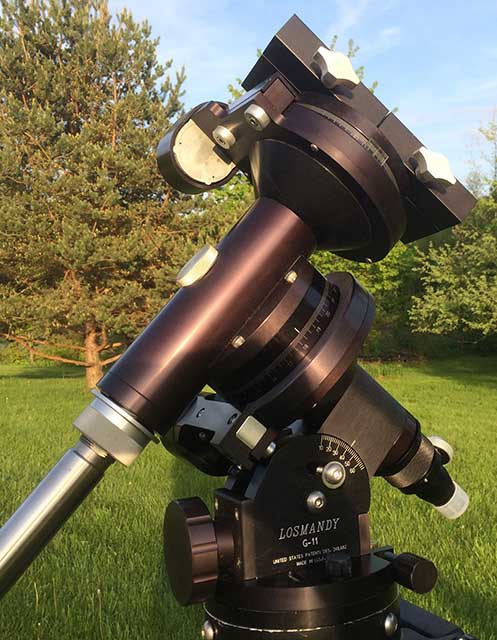
I did eventually find
it necessary to clean out the original grease and replace it
with a synthetic, a fairly easy task that makes a big
difference. One big advantage of this mount is the ease with
which it can be disassembled and worked on by anyone with a
reasonable understanding of how it works.
The mount's main Achilles heel was the exposed position of the motors and their wiring, which were protected only by vinyl covers. It was possible to wipe out the RA motor by turning the telescope too far in one direction or by letting the unbalanced head flop over. I installed optional metal motor covers which eliminate that flaw.
I use my G-11 with a 6"
f/9 refractor, which is pushing the limits of the mount. Still,
it's perfectly satisfactory for visual use. I would be surprised
if it could adequately hold a C-14 tube. I've seen this
combination in use, but I find it more wiggly than I would want
to put up with, especially in any wind.
I upgraded some of the
bearings in my G-11 to the current standard, a process which
uncovered some weaknesses in the design. I had to remove the
worms, a simple enough process, but upon reassembly the drives
had a lot of backlash. Adjusting the worms against the gears was
a trial-and-error process involving making random changes and
then testing the results by looking through the telescope.
Luckily that adjustment does not need to be made often. I've
also replaced the original RA stepper motor with a new one. The
old motors tended to chatter as they operated, pulsing hard
enough to possibly introduce some vibration into the image,
though I never noticed that myself. The new motor is much
quieter and smoother.
As I've grown more
interested in imaging I've also become more aware of the
limitations of the G-11. My particular mount was problematic for
that purpose. I experienced some erratic tracking which I
reduced by fiddling with the way the worm, motor, and coupler
were installed, aligned, and meshed with the worm gear. Results
were inconsistent even with a small, short telescope like my
Stowaway on the mount. Even with an autoguider, stars tended to
be a bit elongated, even when the PHD Guiding software indicated
it wasn't doing much work.
I solved these problems
by adding the Losmandy One Piece Worm Block (OPWB) and brass
"precision worm". After some initial difficulty the mount now
tracks and guides well enough The RA RMS error tends to be
around 0.75", while the total RMS hovers around 1". This
performance is good enough to render round stars with my 6"
refractor with its 1400mm focal length. This is a 35-pound
imaging load that's about five feet long. The G-11 has turned
into a surprisingly good imaging mount for this large payload,
as long as there isn't any wind to speak of. The G-11 is a fine,
relatively inexpensive mount for a wide variety of telescopes.
I also added a One
Piece Worm Block and precision worm to the Declination axis,
reducing backlash significantly. I polar align using a
Polemaster camera. Finally, I added encoders and Nexus II
digital setting circles from Astro Devices. My mount is now
about as fancy as it can be. If I absolutely needed goto I'd
just buy a new one.
I normally prefer
German equatorial mounts, but sometimes it's not practical to
bring one along on a trip. Sometimes I'm just too lazy to set
one up for a quick look. On those occasions I normally used my
TeleVue Telepod head, but I decided I wanted something a little
bigger and smoother to handle my AP Stowaway refractor. On
Cloudy Nights I learned of the DSV-1 altazimuth mount being made
by Raul Medina in Phoenix, available at a good introductory
price of $160. I ordered one; it took a few months to arrive.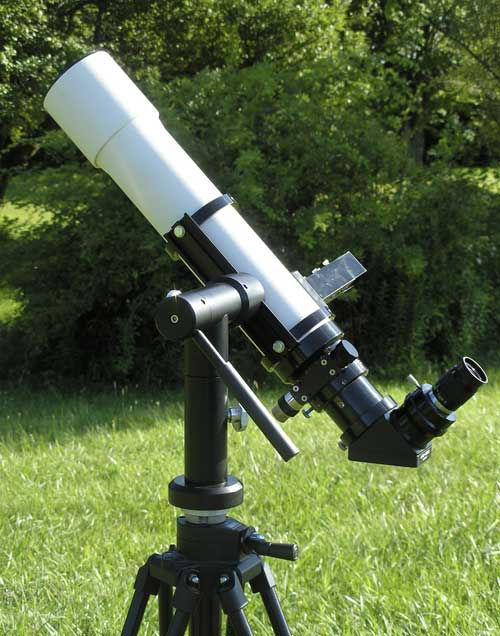
The mount turned out to
be nicely made and very solid. Its design is essentially that of
a German head with the polar axis sticking straight up and no
counterweight. With its standard dovetail clamp, I can now
freely use my scope on either the DSV-1 or on my Skyview Pro
equatorial without swapping out the dovetail bar, as I had to do
when using the Televue head. In use, the mount is pretty stable
with this seven pound scope. Any jiggles can be attributed to my
tripod, which is on the light side for this combination. I'm
able to use it successfully for planetary viewing at powers up
to 200X. One convenient feature of an altaz vs. a German mount
is that the eyepiece and finder orientation remain the same at
all times.
With the scope hanging
off the side of the mount and no counterweights, the mount is
quite sensitive to being level. If off even a little, the mount
will rotate in azimuth. This is the only mount I have which is
sensitive to being level. I've also tried the mount with a
binoviewer in place on my scope, but this doesn't work very
well. I can't push the scope forward far enough to balance it
properly, and because of the weight of the bino sticking up at a
right angle, any altitude balance is lost as you raise or lower
the scope.
The tension of the
mount can be adjusted over a fairly wide range using large hand
knobs. The mount also comes with a pair of Allen wrenches,
though I'm not sure why. As far as I can tell, the Allen screws
only hold the mount together rather than adjusting anything.
Other altazimuth mounts
of similar design exist. I haven't tried any of them. The DSV-1
seems perfectly fine to me, and is much cheaper than those
competing mounts (or at least it was when I bought mine). Many
users of small refractors would need nothing else for quick
looks and convenient low-power scanning.
Raul also sells
dovetail plates, plus accessories for mounting specialized
scopes such as the PST.
Even though it's big, clunky, and made out of polystyrene, I like the venerable Telrad better than the other available 1-power LED sighters. It's easier to align than most of its competitors, and is among the easiest to look through. Its size makes it most appropriate for scopes of 6 inches and bigger. I use one on my 155mm EDT (sorry, Roland).
I use these on my 10" Starsplitter Compact and my 92mm Stowaway because they both need something small and light. The compact base is convenient and solid. Collimation adjustments are predictable. I consider the Quikfinder a very good alternative to the Telrad, and the best choice for very small telescopes, or those with balance issues. It does exhibit more parallax than the Telrad because of its smaller size.
My first Pronto carried one of these, and it did the job perfectly well. It stayed on the scope at all times, and the alignment never budged. Some people complain that the small tinted window makes it too hard to see faint stars, but you're not supposed to use it that way. You look through it with both eyes open and see the dot superimposed against the sky. The tiny exposed circuit board which holds the dimmer control is kinda goofy, but I had no real problem with it. To me the biggest annoyance was the huge green billboard-like logo on the side, right above where it says "Daisy"...
One of these high-end
toys came with my second Pronto. Though certainly the classiest
of all red-dot sighters, and the only one made of metal, I might
not pay $200 for a new one. I did enjoy owning and using one,
and miss it.
Astro-Physics Maxbright 2" Diagonal
Oh-la-la! You wouldn't
think that something doing so unglamorous a job as reflecting
light through a ninety-degree angle could be sexy, but this
thing is. It is beautifully designed, carefully thought out,
immensely solid, and with its advanced high-efficiency
dielectric coating should last for decades. The TeleVue unit is
nice too, but this is the one to get. It might be the only
chance for a lot of people to own any Astro-Physics optical
equipment at all!
I consider the Radians
to be the overall best line of eyepieces I've seen. The balance
of field size, eye relief, sharpness, and contrast is excellent.
With the consistent 20mm eye relief across the line, the shorter
Radians offer phenomenal comfort for planetary observation. I
own the 12mm, 8mm, and 5mm, and they are cornerstones of my
eyepiece set. They perform well at objective focal ratios as
fast as f/4.
TeleVue Type
6 Nagler Eyepieces
I have two of these,
the 7mm and the 3.5mm, and they are vying with the Radians for
my affection. They're small and compact, and their immense field
of view is gorgeous. They don't produce the "kidney bean" or
blackout problems that keep me away from the other Nagler
designs. The 12mm eye relief is not overly generous, but
is usable even with my glasses on (which are thin).
I bought one of these
highly regarded 50mm finders because it offered the features I
wanted: good optics, a right-angle correct image Amici prism,
interchangeable eyepieces, good focusing mechanism, and a
rotating eyepiece position. Since Stellarvue's many fans
encourage treating the F50 more like a small telescope than a
mere finder, I decided to test it as such. This involved using
it with a variety of eyepieces. I don't expect to be using the
included 23mm eyepiece very much. Not that it's a bad eyepiece,
but at 8.7X in the 200mm focal length scope, it gives an exit
pupil of 5.75mm, which is more than my eyes can accomodate.
Consequently, when viewing through this eyepiece, stars look
noticably dimmer than they should, since some of their light is
falling on my iris, not passing through my pupil. I also removed
the reticle from this eyepiece, for a number of reasons. For
one, it's not necessary. I can already tell when something is in
the center of the circular field. Secondly, as the instructions
state, you can barely see it in the dark anyway, unless it's
illuminated, and mine isn't. Third, since it's useless, there's
no sense in letting the plastic disk gobble up any light.
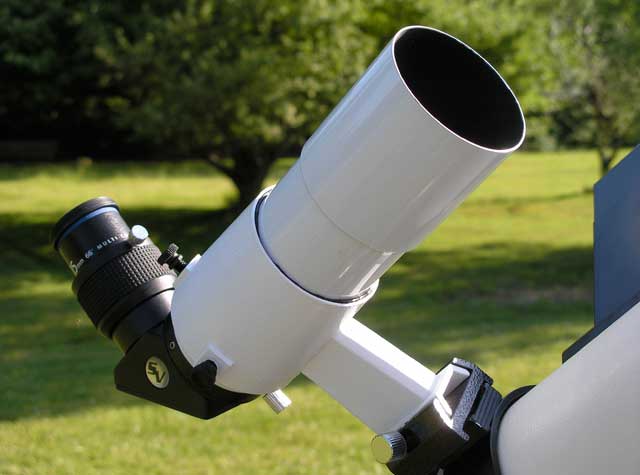 My tests mostly involved a 3.5mm Nagler for 57X,
and a 12mm Radian for 16.7X. The Radian gives a true field of
3.6 degrees and a 3mm exit pupil. This results (for me) in
brighter stars, a darker background, and deeper penetration than
the stock eyepiece. The field is smaller than the original 6
degrees, but is still big enough for a finder, especially when
used in conjunction with a Telrad. If I felt like spending $200
or more on an eyepiece for a $120 finder, my first choices would
be the 14mm or 18mm Radian.
My tests mostly involved a 3.5mm Nagler for 57X,
and a 12mm Radian for 16.7X. The Radian gives a true field of
3.6 degrees and a 3mm exit pupil. This results (for me) in
brighter stars, a darker background, and deeper penetration than
the stock eyepiece. The field is smaller than the original 6
degrees, but is still big enough for a finder, especially when
used in conjunction with a Telrad. If I felt like spending $200
or more on an eyepiece for a $120 finder, my first choices would
be the 14mm or 18mm Radian.
I examined Sirius at
57X. Yes, I saw some violet color error at this power, hardly a
surprise for an f/4 objective. I could also see a faint spike
radiating from both sides of the star, an artifact of the Amici
prism. This was quite subdued and not obtrusive, much better
controlled than I've seen from some other Amici diagonals. I
might not notice it at all on a star which was much fainter. I
performed a quick star test using Polaris. The Fresnel pattern
was neat, round, and well-defined on one side of focus. On the
other side I could see a vague dark line crossing the pattern,
again an artifact of the angle of the Amici prism. This star
test was much better than any I ever got from the 60mm "Baby
Brandon" refractor which I also use as a finder, and which has
some serious optical issues.
I looked at Saturn,
which revealed a tiny ringed image. When focused for the best
sharpness, a small disk of spurious light expanded out of the
planet, compromising the view. I suspect this too is due to the
presence of the Amici prism, which are really not well suited to
high power astronomical use. Luckily, I don't intend to do much
planetary observing with the F50! Titan was dimly visible.
Finally, I could barely split Gamma Leonis, or Algieba, at this
power.
Dropping down to 16.7X,
I viewed a number of deep sky targets to assess the F50's
usefulness as an actual finder. I was quite pleased by what it
could reveal. Sky conditions were only fair that night. My site
is somewhat dark, but the sky had large areas of thin gauzy
clouds which muted the stars if they snuck up on me.
Nevertheless, the F50 showed crisp fields full of sharp stars. I
had a surprisingly extensive view of M42 which included the full
loop of the curving outer arms. M1, the Crab Nebula, was easily
visible as a little smudge. The Double Cluster was a pleasingly
sparkly assemblage of stars, as was M35. Most surprisingly, I
could even see NGC 2158 as a tiny blur just to the side of the
big cluster. Naturally I also had nice views of big clusters
like the Pleaides and Beehive.
As I sat there looking
through this tiny telescope, contemplating all it was capable of
showing, it occured to me that people who claim you can't really
see anything through relatively gigantic 3" or 4" telescopes may
be a tiny bit spoiled and jaded.
Mechanically, the F50
is pretty nice, with a couple of caveats. One is the main lens
cap: it's lame. Very loose, it easily falls off. The helical
focuser is nice to have, but overly stiff. At 32 degrees
Fahrenheit, it became so hard to turn that I had to hold on with
both hands, lest I unscrew the whole assembly from the diagonal.
Since this test I
bought a used 15mm Orion Expanse widefield eyepiece, looking for
an economical way to get a higher power from this finder. It
turned out to be a poor choice, showing highly astigmatic stars
in the outer parts of the field. Even in my long-focus Questar
telescope this eyepiece shows astigmatism. It's a good example
of what you get when you try to go cheap on a wide-field
eyepiece: not much. While usable in the finder, the view is
quite ugly, and does not properly represent the views which are
possible through this little scope. I find it unfortunate that
these finders are made with objectives of f/4 or even faster. It
keeps them short and light, but it means they need eyepieces
twice as expensive as the finders themselves to perform at their
best. I vote for f/6.
Overall, the F50 is the
most sophisticated, best working 50mm finder I've seen.
VERNONscope
"Brandon" 94mm Refractor
I owned one of these
from 1989 to 1991. It was a handsome thing, with its baby blue
tube, wooden tripod, and classic Unitron equatorial mount, but
ultimately the only thing I really liked about it was the
Christen triplet objective. In other respects I found that it
wasn't well designed for actual use. Permit me to enumerate its
deficiencies:
The scope came with an
impressive grey graphite case which nevertheless was too short
to hold the fully assembled tube. To store the scope you had to
unscrew the dewcap, remove the drawtube, and stick them in
separate compartments in the case.
The 2" Unitron focuser
looked better than it worked. The clamps were not very positive
and weren't strong enough to lock down the focuser for any kind
of photography. The drawtube was not blackened internally, but
chromed, making the telescope useless when used straight
through, since the shiny tube bounced all manner of stray light
around.
The finder was the
worst I have seen. Stars were horrid astigmatic messes, so poor
that the finder was nearly useless.
The mount charmed me as
someone who still has a Unitron catalog from the 70s, and it
supported the scope adequately, but I still found it poorly
designed. The multiple clamps and slow motion controls were a
confusing forest of stalks to navigate by feel. The declination
control was far too coarse to be of any use for photography. The
clock drive had to take up a lot of slack before it actually
began to move the scope. The mount head came in a cool wooden
case though.
This scope would have
made a great ornament, and it could certainly be used for
successful viewing, but too many deficient details and instances
of poor ergonomics led me to sell the instrument with only mild
regret. The nice lens was similar in design to the original
Christen triplet, and showed some color, but was good enough for
all but the pickiest user.
Short-focus achromatic
refractors have been a bit of a fad for the past few years,
largely due to the popularity of the cheap imports from China.
Since I am wise beyond other men, I have been using small short
refractors for the past 45 years. They all came from those
curious, modest, pumpkin-patch sincere A. Jaegers catalogs,
through which newer amateur astronomers have not been privileged
to pore. Jaegers refractors could not be purchased complete, but
only as parts to be assembled. My first was a 1972 3.25" f/15,
my first serious telescope. The telescope, complete with an
Edmund equatorial mount and two Brandon eyepieces, cost $180 (I
would have gotten a 4" if I hadn't splurged $36 for the pair of
Brandons).
In 1974 I built a 3"
f/6.5 for targets like the Pleiades nebulosity, the Veil, and
the North America Nebula, objects which amateurs were just then
realizing could actually be seen. It was a fine little scope
which I would probably still have save for a shameful mishap. I
managed to fracture the objective while trying to remove the
cell from the tube (I will say no more). I eventually sold the
poor thing as a finder on a larger scope.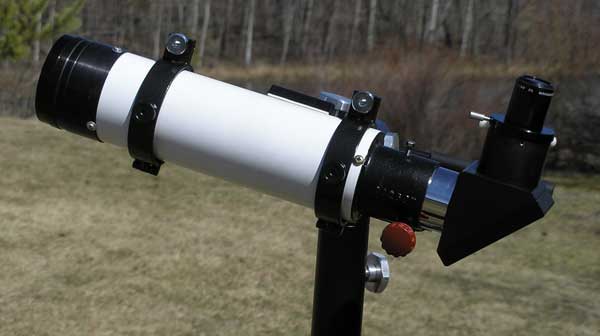
In 1981 I decided to
try a longer version of this sort of scope, an f/8.6, hoping for
better performance. It was a decent enough scope but didn't
really suit my purposes, being physically too long to ride
comfortably on the cheap camera tripod I was using as a mount.
So in 1983 I sold that lens and adapted the tube assembly to
hold another 3" f/6.5. I still have this scope, my only relic of
the days when all my scopes were assembled by me (since then
I've realized that other people are equipped to do a better job
than I am).
The lens is not as good
as the original, showing slight astigmatism at high powers. The
spherical correction looks good.
I have steadily refined
the tube assembly over the years. I flocked it and added tube
rings and a dovetail bar. At this point its biggest weakness is
the clunky 2" focuser, which is similar to the old red-knobbed
Jaegers focusers, but came instead from a strange long-defunct
company in the Philadelphia area. I have improved it by adding
Teflon tape to take out some of the slop.
In comparing the scope
to a TeleVue Pronto, the Jaegers shows a noticeably brighter
image, color correction which is only slightly worse, and
similar levels of planetary detail. This venerable scope's
shining moment came when I used it to stare at the phenomenal
beauty of the solar corona during the 1991 eclipse in La Paz,
Mexico. It has also played a role at various partial and annular
eclipses, and served as a finder on my old 14.5" Dobsonian.
It's too bad today's
observers don't have the option of assembling refractors from
Jaegers.
Words copyright by Joe Bergeron.
 |
 |
 |
 |
 |
 |
 |